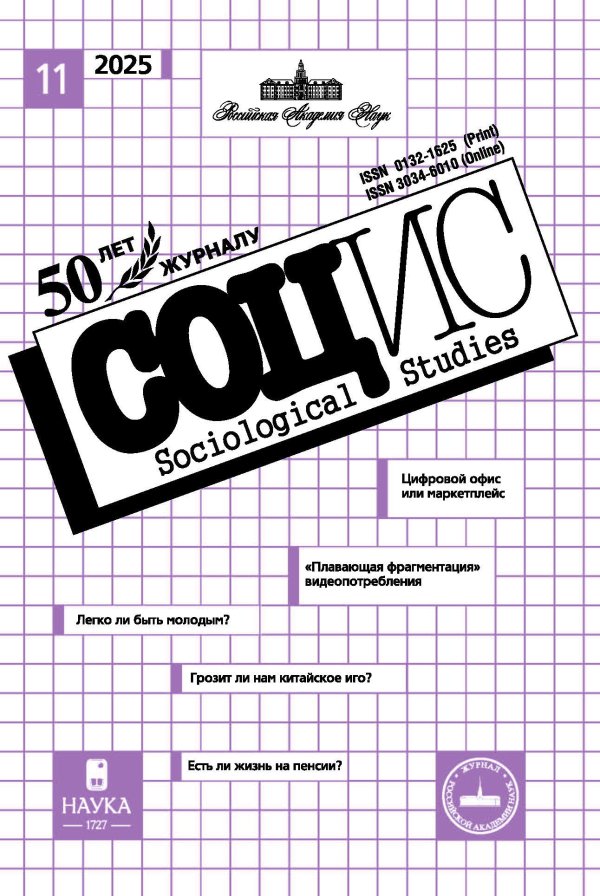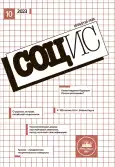Fuzzy Classifications in the Typological Analysis of Workers by Employment Instability
- Authors: Kuchenkova A.V.1, Tatarova G.G.1
-
Affiliations:
- Institute of Sociology FCTAS RAS
- Issue: No 10 (2023)
- Pages: 27-40
- Section: Articles
- URL: https://journals.rcsi.science/0132-1625/article/view/251497
- DOI: https://doi.org/10.31857/S013216250028302-5
- ID: 251497
Full Text
Abstract
About the authors
Anna V. Kuchenkova
Institute of Sociology FCTAS RASRussian Federation, Moscow
Galina G. Tatarova
Institute of Sociology FCTAS RASRussian Federation, Moscow
References
- Вятченин Д.А. Нечеткие методы автоматической классификации. Мн.: Технопринт, 2004.
- Галицкая Е.Г., Галицкий Е.Б. Деревья классификаций // Социологические исследования. 2013. № 3. С. 84–87.
- Гасюкова Е.Н., Карачаровский В.В., Ястребов Г.А. Разный прекариат: об источниках и формах нестабильности социального статуса индивидов и групп // Общественные науки и современность. 2016. № 3. С. 48–63.
- Гасюкова Е.Н., Петрова А.А. Субъективные оценки нестабильной занятости: так ли уж плохо быть нестабильным? // Экономическая социология. 2021. Т. 22. № 3. С. 39–70.
- Дёмин А.Н. Индекс прекарности для психологического изучения российского рынка труда // Организационная психология. 2022. Т. 12. № 4. С. 103–122. doi: 10.17323/2312-5942-2022-12-4-103-122.
- Заде Л.А. Размытые множества и их применение в распознавании образов и кластер-анализе // Классификация и кластер / Под ред. Дж. Вэн Райзина; пер с англ.; под ред. Ю.И. Журавлева. М: Мир, 1980. С. 208–247.
- Кученкова А.В., Колосова Е.А. Дифференциация работников по характеру неустойчивости их занятости // Мониторинг общественного мнения: Экономические и социальные перемены. 2018 № 3 С. 288–305. doi: 10.14515/monitoring.2018.3.15.
- Неустойчивая занятость в Российской Федерации: теория и методология выявления, оценивание и вектор сокращения: научная монография / Гл. науч. ред. В.Н. Бобков. М.: КНОРУС, 2018.
- Попов А.В. Влияние прекаризации занятости на положение наемных работников: социологический аспект // Вопросы территориального развития. 2019. № 5(50). С. 1–13. doi: 10.15838/tdi.2019.5.50.8.
- Попов А.В., Соловьева Т.С. Прекаризация занятости: анализ научного дискурса о сущности и векторах измерения // Социологические исследования. 2020. № 9. С. 103–113. doi: 10.31857/S013216250009618-2.
- Смирнова А.Ю. Двухкомпонентная модель субъективной незащищенности в сфере труда в зарубежных исследованиях: психологическое содержание и диагностика феномена // Известия Саратовского ун-та. Новая серия. Сер. Философия. Психология. Педагогика. 2015. № 4. С. 99–106.
- Стребков, Д.О., Шевчук, А.В. Что мы знаем о фрилансерах? Социология свободной занятости. М.: ВШЭ, 2022.
- Татарова Г.Г. Основы типологического анализа в социологических исследованиях. Уч. пос. М.: Высшее Образование и Наука, 2007.
- Татарова Г.Г., Бессокирная Г.П. Идентификация рабочих с предприятием в диагностике производственной ситуации // Социологические исследования. 2019. № 4. С. 43–56. doi: 10.31857/S013216250004585-6.
- Темницкий А.Л. Ресурсный потенциал прекарных работников в России // Социологические исследования. 2022. № 11. С. 86–99. doi: 10.31857/S013216250021065-4.
- Типологический анализ в социологии как диагностическая процедура / Отв. ред. Г.Г. Татарова, А.В. Кученкова. М.: ФНИСЦ РАН, 2023.
- Типология и классификация в социологических исследованиях / Отв. ред. В.Г. Андреенков, Ю.Н. Толстова. М.: Наука, 1982.
- Толстова Ю. Н. Математические методы в социологии // Социология в России / Под ред. В.А. Ядова. М.: ИС РАН, 1998. С. 83–89.
- Тощенко Ж.Т. Публичный и приватный жизненный мир прекариата: основные черты и ориентиры // Социологические исследования. 2021. № 11. С. 24–36. doi: 10.31857/S013216250016200-3.
- Хорошилов Д.А. Онтологическая, социальная и психологическая прекарность: пути взаимодействия в транзитивном обществе // Новые психологические исследования. 2021. № 2. С. 64–83. doi: 10.51217/npsyresearch_2021_01_02_04.
- Шкаратан О.И., Карачаровский В.В., Гасюкова Е.Н. Прекариат: теория и эмпирический анализ (на материалах опросов в России, 1994-2013) // Социологические исследования. 2015. № 12. С. 99–110.
- Collier D. Typologies: forming concepts and creating categorical variables / D. Collier, J. La Porte, J. Seawright // J. M. Box-Steffensmeier, H. E. Brady, D. Collier, eds., Oxford Handbook of Political Methodology. Oxford: Oxford University Press, 2008. P. 152–173. doi: 10.1093/oxfordhb/9780199286546.003.0007.
- Hudson J., Kühner S. Beyond indices: The potential of fuzzy set ideal type analysis for cross-national analysis of policy outcomes // Policy and Society. 2013. Vol. 32. Iss. 4. P. 303–317. doi: 10.1016/j.polsoc.2013.10.003.
- It’ s More than Poverty: Employment Precarity and Household Well-being / Poverty and Employment Precarity in Southern Ontario (PEPSO), McMaster University and United Way Toronto; ed. S. McBeth. 2013. URL: https://labourstudies.mcmaster.ca/pepso/documents/2013_itsmorethanpoverty_report.pdf (дата обращения: 03.09.2023).
- Kvist J. Fuzzy set ideal type analysis // Journal of Business Research. 2007. Vol. 60. Iss. 5. P. 474–481.
- Vives A., Gonzáleza F., Moncadae S., Llorense C., Benach J. Measuring precarious employment in times of crisis: the revised Employment Precariousness Scale (EPRES) in Spain // Gaceta Sanitaria. 2015. No. 29(5). P. 379–382.
- Zadeh L. Fuzzy sets // In formation control. 1965. Vol. 8. P. 338–353. doi: 10.1016/S0019-9958(65)90241-X.










